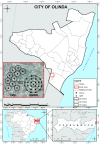No evidence of Zika, dengue, or chikungunya virus infection in field-caught mosquitoes from the Recife Metropolitan Region, Brazil, 2015
- PMID: 31363498
- PMCID: PMC6644828
- DOI: 10.12688/wellcomeopenres.15295.1
No evidence of Zika, dengue, or chikungunya virus infection in field-caught mosquitoes from the Recife Metropolitan Region, Brazil, 2015
Abstract
Background: The Recife Metropolitan Region (RMR), north-eastern Brazil, was the epicentre of the 2015 Zika virus (ZIKV) epidemic, which was followed by a 2016 chikungunya virus (CHIKV) epidemic. It historically has amongst the highest incidence of dengue virus (DENV) infections and is the only remaining focus of lymphatic filariasis (LF) in Brazil. In early 2015, a molecular xenomonitoring surveillance project focused on Culex (Cx.) quinquefasciatus commenced to inform LF elimination activities. Aedes (Ae.) aegypti mosquitoes were also collected, concurrent with the first microcephaly cases detected in the RMR. In terms of the 2015 ZIKV epidemic, these are the earliest known field-collected mosquitoes, preserved for potential RNA virus detection, when ZIKV was known to be circulating locally. Methods: Adult mosquitoes were collected in two sites (0.4 km 2) of Sítio Novo, Olinda, RMR, from July 22 to August 21, 2015. Mosquitoes were morphologically identified, sorted by physiological status, and pooled (up to 10 mosquitoes per house per day or week). RNA was extracted, reverse transcribed and the cDNA tested by real-time PCR. Results: A total of 10,139 adult female Cx. quinquefasciatus and 939 adult female Ae. aegypti were captured. All female Ae. aegypti specimens were included within 156 pools and screened for ZIKV, DENV and CHIKV. In addition, a sub-set of 1,556 Cx. quinquefasciatus adult females in 182 pools were screened for ZIKV. No evidence of infection with any of the three arboviruses was found. Conclusions: The absence of arbovirus detection may have been expected given the extremely restricted geographic area and collection of mosquitoes during a very short time period of peak mosquito abundance (July-September), but low arbovirus circulation (November-March). However, this study demonstrates the potential to retrospectively screen for additional unexpected pathogens in situations of rapid emergence, such as occurred during the outbreak of ZIKV in the RMR.
Keywords: Aedes aegypti; Culex quinquefasciatus; Zika virus; arboviruses; chikungunya virus; dengue virus; disease surveillance; molecular xenomonitoring; neglected tropical diseases; urban areas.
Conflict of interest statement
No competing interests were disclosed.
Figures



Similar articles
-
Entomo-virological surveillance strategy for dengue, Zika and chikungunya arboviruses in field-caught Aedes mosquitoes in an endemic urban area of the Northeast of Brazil.Acta Trop. 2019 Sep;197:105061. doi: 10.1016/j.actatropica.2019.105061. Epub 2019 Jun 10. Acta Trop. 2019. PMID: 31194961
-
Development of an urban molecular xenomonitoring system for lymphatic filariasis in the Recife Metropolitan Region, Brazil.PLoS Negl Trop Dis. 2018 Oct 16;12(10):e0006816. doi: 10.1371/journal.pntd.0006816. eCollection 2018 Oct. PLoS Negl Trop Dis. 2018. PMID: 30325933 Free PMC article.
-
Vertebrate-Aedes aegypti and Culex quinquefasciatus (Diptera)-arbovirus transmission networks: Non-human feeding revealed by meta-barcoding and next-generation sequencing.PLoS Negl Trop Dis. 2020 Dec 31;14(12):e0008867. doi: 10.1371/journal.pntd.0008867. eCollection 2020 Dec. PLoS Negl Trop Dis. 2020. PMID: 33382725 Free PMC article.
-
Prevalence of dengue, Zika, and chikungunya virus infections among mosquitoes in Asia: A systematic review and meta-analysis.Int J Infect Dis. 2024 Nov;148:107226. doi: 10.1016/j.ijid.2024.107226. Epub 2024 Aug 29. Int J Infect Dis. 2024. PMID: 39216785
-
Minireview: Epidemiological impact of arboviral diseases in Latin American countries, arbovirus-vector interactions and control strategies.Pathog Dis. 2021 Sep 6;79(7):ftab043. doi: 10.1093/femspd/ftab043. Pathog Dis. 2021. PMID: 34410378 Review.
Cited by
-
Arbovirus surveillance in mosquitoes: Historical methods, emerging technologies, and challenges ahead.Exp Biol Med (Maywood). 2023 Nov;248(22):2072-2082. doi: 10.1177/15353702231209415. Epub 2024 Jan 6. Exp Biol Med (Maywood). 2023. PMID: 38183286 Free PMC article. Review.
-
Postintervention Immunological and Entomological Survey of Lymphatic Filariasis in the City of Olinda, Brazil, 2015-2016.Am J Trop Med Hyg. 2024 Feb 13;110(3):470-482. doi: 10.4269/ajtmh.23-0174. Print 2024 Mar 6. Am J Trop Med Hyg. 2024. PMID: 38350158 Free PMC article.
-
Is the ZIKV Congenital Syndrome and Microcephaly Due to Syndemism with Latent Virus Coinfection?Viruses. 2021 Apr 13;13(4):669. doi: 10.3390/v13040669. Viruses. 2021. PMID: 33924398 Free PMC article. Review.
-
The use of molecular xenomonitoring for surveillance of mosquito-borne diseases.Philos Trans R Soc Lond B Biol Sci. 2021 Feb 15;376(1818):20190816. doi: 10.1098/rstb.2019.0816. Epub 2020 Dec 28. Philos Trans R Soc Lond B Biol Sci. 2021. PMID: 33357052 Free PMC article. Review.
-
Spondweni virus causes fetal harm in Ifnar1-/- mice and is transmitted by Aedes aegypti mosquitoes.Virology. 2020 Aug;547:35-46. doi: 10.1016/j.virol.2020.05.005. Epub 2020 May 24. Virology. 2020. PMID: 32560903 Free PMC article.
References
-
- World Health Organization (WHO): A Global Brief on Vector Borne Diseases. Geneva; WHO/DCO/WHD/2014.1:2014. Reference Source
-
- World Health Organization (WHO): Global vector control response 2017–2030. Geneva: WHO; Licence: CC BY-NC-SA 3.0 IGO: 2017 Contract No.: Licence: CC BY-NC-SA 3.0 IGO. Reference Source
-
- United Nations Department of Economical and Social Affairs (DESA): World Urbanization Prospects 2018. New York, NY USA: United Nations,2018. Reference Source
Grants and funding
LinkOut - more resources
Full Text Sources

